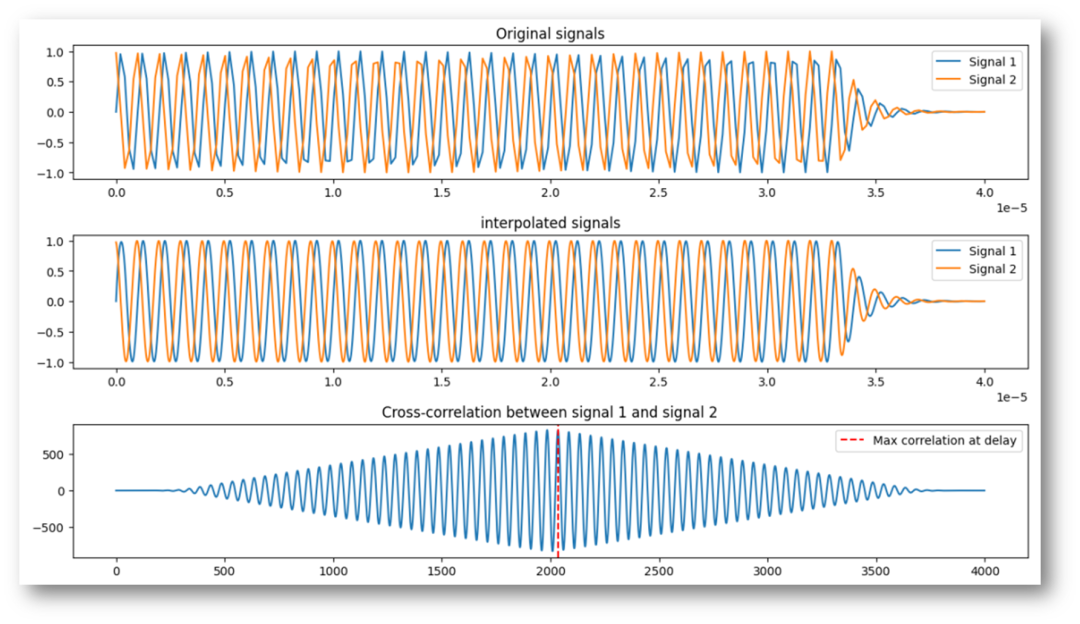

超声流量传感器信号采样率的影响
描述
我们在之前在《流量传感器(2)—超声流量传感器,相位差和相关性原理》中曾留了一个问题:如果采样频率不一样,模拟的结果会怎么样?不知道大家有没有时间去运行测试一下,反正小编尝试了。测试的结果(但不是最终结论,请根据实际应用进行调整)下文会提到。
在小编上次关于超声流量的相关信号处理的模拟中,用到了插值的方式,不过由于没有经过太多的测试,在后续测试过程中,发现当声速为4500m/s的模拟流体的流速不超过15m/s时,都没有什么问题;但是当模拟的流速超过15m/s之后,两组模拟信号的相位差超过了180°时,获取相关性序列中对应的时间值时,发现取值结果为负数。
相位差180°,这本身没有问题,但是由于数据的相关性处理函数是个偶函数,对称于中点,所以在数据相关性处理中,当两路信号的相位差超过180°前后时,因为两路测试信号是正余弦形式,相当于其中一路信号序列在相对于另外一路信号序列移动的时候,在某个相对处的相关计算结果,可以找到另外一个错位的对方有相同的相关处理结果,然而在查找标识相位偏差所对应的最大值时间序列值时,测试代码优先输出了最左侧编号是负数的相位序列,实际应该输出相关性序列中点右侧的最大值所对应的时间序列值。结果可想而知,计算的流速变成了负数。修改后的代码中,计算流速时,使用的相关性序列是整个相关结果序列的右边部分,就解决了输出流速突然变成负数的问题。
另外,实际的超声波接收信号并不会是从头至尾都是理想的正余弦,因此,我们看到的模拟信号似乎也是太过于理想。这里我们稍微加了点料,让稳定的信号后面加上了快速衰减。
在进行模拟信号相关性处理的时候,之前我们使用的是直接死磕方式的计算,这里调整为快速傅里叶计算(FFT)。
所以,这里我们将模拟代码作了以下调整,顺便作了在不同采样频率下的模拟测量值比较:
在原来的模拟超声波接收信号的生成数据中,加入最后衰减的部分;
在生成的相关性序列中,只取中间点右侧的一半作为分析处理部分;
图像输出时,仍然输出全部的相关性序列;
在生成相关性序列时,需用了FFT的模式(原先的选用的直算的方式);
降低“采样频率”到5MHz,然后采样插值的方式进行相关性处理。

上图模拟的是16m/s下,5MHz采样率,得到的输出值:
T1_0: 4.5617943222309144e-07
Length of t lags: 2000
Ts Delayed cycles: 23 ,
Delayed time: 4.6e-07
degree(相位差,角度): 165.6
Sample time interval(采样间隔时间): 2.0e-08
Estimated velocity: 16.134001423268288(m/s)
不同采样率,不同模拟流速下的模拟输出比较(都有插值)

从模拟结果来看,较高的采样率确实可以获得较高的测量精度,而低的采样率,虽然适用了插值提高了测量精度,但是插值运算毕竟是基于我们设定了波形的形态进行的。实际应用,还是要根据实际需求和情况配置相关的软硬件功能。
另外需要说明的是,在整个信号相关性处理的模拟过程中,这里并没有将相关性结果序列归一化后输出,而是使用直接结果的方式。
小编还要留一个问题:如果插值处理中标识插值点数的参数有变化的时候,模拟结果会出现什么变化?欢迎大家测试并留个回复。
修改之后的模拟代码
其中:模拟代码中的噪声部分是被注释掉的
import numpy as np
import matplotlib.pyplot as plt
from scipy.signal import correlate
import math
from scipy.interpolate import interp1d
def cor_demo():
try:
# Parameters
c = 4500 # Sound speed in the fluid in m/s
d = 0.5 # Pipe diameter in meters
theta = math.pi / 6 # Angle of the emitted ultrasound wave, in radians. 30 degrees here.
L = d / math.cos(theta) # The sound path length in meters parallel to the flow direction
v = 16 # Fluid velocity in m/s
f = 1e6 # Frequency of the signal in 1MHz
T = 1 / f # Period of the signal in s
Fs = 5e6 # 采样频率为5MHz
Ts = 1/Fs # 采样间隔
# Calculate time delay caused by flow velocity
time_up = L / (c - v * math.sin(theta)) # Time of flight upstream
time_down = L / (c + v * math.sin(theta)) # Time of flight downstream
print("T1_0:",time_up-time_down)
t_delay = 2 * L * v * np.sin(theta) / (c**2 - v**2 * np.sin(theta)**2)
# Time array
# 返回一个从0到period*T范围内的有num_samples个元素的一维数组,数组中的数值是等间距分布的
period = 40
num_samples = period*T/Ts
t = np.linspace(0, period*T, int(num_samples))
t_max = t.max()
t_start_decay = t_max * 5/6
# 定义信号衰减准则 - 衰减系数一般由物质的特性决定
attenuation_coefficient = 10e5
# Signals
stationary_s0 = np.sin(2 * np.pi * f * t[t=t_start_decay])* np.exp(-attenuation_coefficient * (t[t >= t_start_decay] - t_start_decay))
decay_s1 = np.sin(2 * np.pi * f * (t[t>=t_start_decay]-t_delay))* np.exp(-attenuation_coefficient * (t[t >= t_start_decay] - t_start_decay))
#s0 = np.sin(2 * np.pi * f * t)* np.exp(-attenuation_coefficient * t)
#s1 = np.sin(2 * np.pi * f * (t - t_delay))* np.exp(-attenuation_coefficient * t) #*2.0 # Signal 1
s0 = np.concatenate([stationary_s0, decay_so])
s1 = np.concatenate([stationary_s1, decay_s1])
"""
noise0 = np.random.normal(0, 0.5, s0.shape)
noise1 = np.random.normal(0, 0.5, s1.shape)
s0 = s0 + noise0
s1 = s1 + noise1
"""
# Define interpolation factor
interp_factor = 10
# New time vector after interpolation
t_new = np.linspace(t.min(), t.max(), t.size * interp_factor)
# Create a function based on the original signals, which can be used to generate the interpolated signals
interp_func_s0 = interp1d(t, s0, kind='cubic')
interp_func_s1 = interp1d(t, s1, kind='cubic')
# Generate the interpolated signals
s0_new = interp_func_s0(t_new)
s1_new = interp_func_s1(t_new)
# 计算Cross-correlation,并找到最大值对应的位置
#correlation = correlate(s1, s0, method='direct', mode='full') # old
correlation = correlate(s1_new, s0_new, method='fft', mode='full')
# 找出该序列的长度 len_corr 和其中间点 mid_index
len_corr = len(correlation)
mid_index = len_corr // 2
#取序列中间值右边的序列(包含中间值)
corr_half = correlation[mid_index:]
#lags = np.arange(-len(s1_new) + 1, len(s1_new)) # Lags array
lags = np.arange(0, len(s1_new)) # Lags array
print("Length of t lags:", len(lags))
# Calculate flow speed using the estimated time delay
# Find the peak of the cross-correlation corresponds to the time delay
delay = lags[np.argmax(corr_half)] # 相位差所对应的信号序列值
# 采样时间
sample_time = (period*T) / len(t_new)
time_delay = delay * sample_time # 两个信号间的延迟时间
phase_shift = (time_delay / T) * 2 * np.pi # 由时间延迟换算成的两个信号序列的相位差
phase_shift_deg = phase_shift * (180 / np.pi) # 由相位差换成的两个信号序列的角度差
print("Ts Delayed cycles:", delay, ", Delayed time: ", time_delay, "degree:", phase_shift_deg) # 将延迟转换为相位差
print("Sample time interval:",sample_time)
# 计算所得的流速
v_estimated = (math.sqrt((L**2)+(time_delay**2)*(c**2))-L)/(time_delay * math.sin(theta))
print('Estimated velocity: ', v_estimated)
# 输出图
fig, (ax_origin, ax_interpo, ax_corr) = plt.subplots(3, 1, figsize=(12, 8))
# 原始信号图
ax_origin.plot(t, s0, label='Signal 1')
ax_origin.plot(t, s1, label='Signal 2')
ax_origin.set_title('Original signals')
ax_origin.legend()
# 插值后的信号图
ax_interpo.plot(t_new, s0_new, label='Signal 1')
ax_interpo.plot(t_new, s1_new, label='Signal 2')
ax_interpo.set_title('interpolated signals')
ax_interpo.legend()
# 互相关图
ax_corr.plot(correlation)
ax_corr.axvline(x = len(correlation)//2 + delay, color = 'r', linestyle = '--', label = "Max correlation at delay")
ax_corr.set_title('Cross-correlation between signal 1 and signal 2')
ax_corr.legend()
plt.tight_layout()
plt.show()
return
except Exception as e:
print("Error:",e)
if __name__=='__main__':
cor_demo()
-
ADC采样率与信号频率:关键概念与设计要点2025-05-13 3068
-
FIR滤波器采样率与信号采样率的关系2016-08-18 15697
-
什么是流量传感器2018-11-08 3222
-
基于UKF的变采样率多异质传感器异步数据融合2017-01-08 938
-
示波器的采样率不足对测试结果有什么影响?2020-03-13 12910
-
什么是示波器的采样率2022-09-14 5506
-
什么是信号采样率?如何更改信号的采样率?2023-06-20 5366
-
什么叫采样率 数字信号处理时钟与采样率的关系2023-08-17 6458
-
adc采样率和带宽的关系2023-09-12 20031
-
模拟传感器的采样率2023-10-04 864
-
什么是示波器的实时采样率?什么是示波器的等效时间采样?2023-10-17 3243
-
波形实测,采样率越高噪声越大??2023-12-08 2163
-
示波器带宽与采样率的关系2024-05-17 7835
-
如何优化adc的采样率2024-10-31 2422
-
什么是传感器的采样率2024-12-05 2042
全部0条评论

快来发表一下你的评论吧 !

